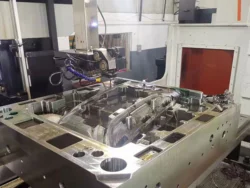Waterjet cutting technology is crucial in manufacturing due to its ability to cut a diverse range of materials with precision. It’s a cold-cutting process, which means it doesn’t affect the properties of the material being cut.
What is Waterjet Cutting?
This process involves using a jet of water at high velocity and pressure to cut through materials. When abrasive is added, it’s known as abrasive waterjet cutting.
How Does Waterjet Cutting Work?
- Designing the cutting path using CAD software.
- Generating the waterjet stream.
- Adding abrasive materials to the stream for harder materials.
- Manipulating the stream to cut through the material.
- Cleaning and finishing the cut material.
The Benefits of Waterjet Cutting for Manufacturing
- Precision: Capable of achieving tight tolerances and intricate cuts.
- Versatility: Cuts a wide range of materials without changing tools.
- Eco-Friendliness: Generates no hazardous waste and uses recyclable abrasives.
Why Choose Waterjet Cutting Over Other Cutting Methods?

Waterjet cutting doesn’t induce heat stress, preserves the integrity of materials, and allows for the cutting of complex shapes without the need for secondary finishing.
What Materials Can Be Effectively Cut With Waterjet Technology?
- Metals: Including steel, aluminum, and alloys.
- Composites: Like fiberglass and carbon fiber.
- Glass: Including bulletproof glass.
- Stone and Tiles: For custom inlays and complex designs.
- Rubber and Plastics: With no melting or warping.
How Precise is Waterjet Cutting?
Cutting tolerances can be as tight as ±0.005 inches (±0.13 mm), depending on the machine and material.
Can Waterjet Cut Through Thick Materials?
Waterjet cutting can handle materials several inches thick, with exact capabilities depending on the specific machine used.
The Technical Aspects of Waterjet Cutting Machines

These machines typically include a high-pressure pump, a cutting head with a nozzle, and an abrasive feed system.
What are the Main Parameters of Waterjet Cutting?
- Pressure: Usually up to 60,000 psi or more.
- Nozzle Size: Determines the precision of the cut.
- Abrasive Flow Rate: Affects the speed and quality of the cut.
- Cut Speed: Balances cut quality with efficiency.
Optimizing Waterjet Cutting Operations
Best practices include regular machine maintenance, optimizing cutting paths for efficiency, and choosing the right abrasive.
Design Considerations for Waterjet Cutting
Factors like material choice, thickness, and complexity of design can impact the quality of the cut. Preparing files involves using CAD software to create precise cutting paths.
Cost Analysis of Waterjet Cutting
While initial costs can be high due to equipment and materials, operational costs are competitive, especially for complex or thick materials that would require costly secondary processing with other methods.
Waterjet Cutting Safety and Environmental Considerations

Waterjet cutting is safe when proper safety measures are in place, such as guarding and protective equipment. It’s also environmentally friendly due to its low waste production and the absence of hazardous materials.
Case Studies: Success Stories in Waterjet Cutting
Industries like aerospace, automotive, shipbuilding, and art and design have seen significant benefits from the precision and versatility of waterjet cutting.
Choosing a Waterjet Cutting Service or Equipment
Selecting a service or equipment involves considering the provider’s experience, the support they offer, the capabilities of their machines, and their certifications.
The Future of Waterjet Cutting in Manufacturing
Advancements in control software, pump technology, and nozzle design are expected to increase the capabilities and reduce the costs of waterjet cutting.
Conclusion
Waterjet cutting is a key technology in modern manufacturing that offers unmatched versatility and precision. It enables manufacturers to cut a wide array of materials efficiently and cost-effectively while minimizing environmental impact.


